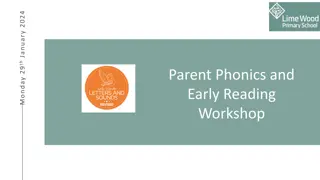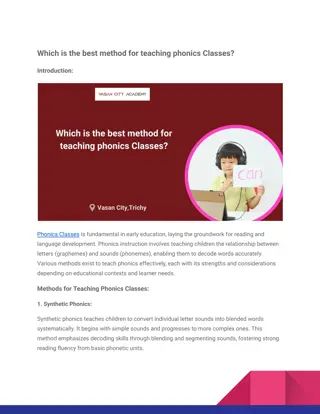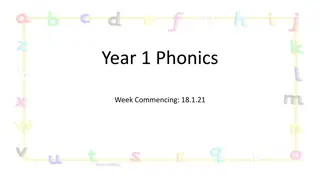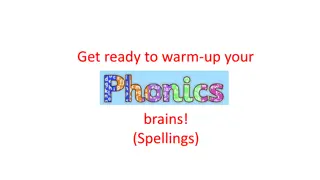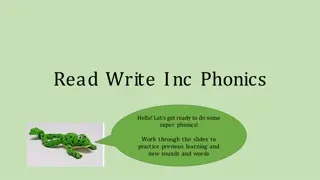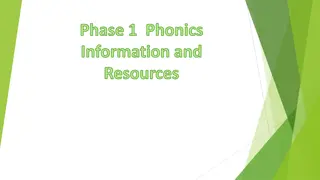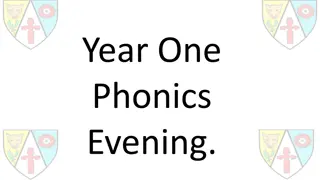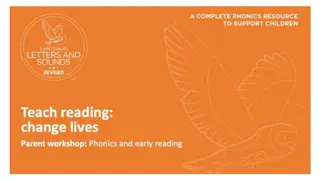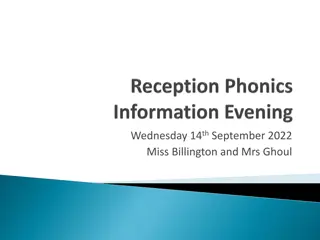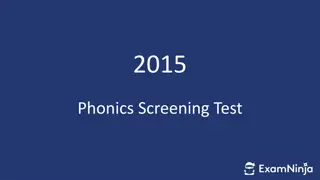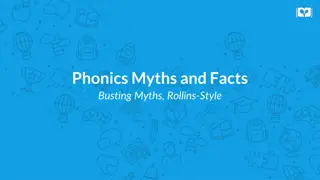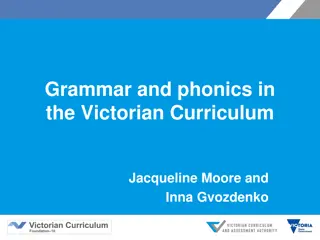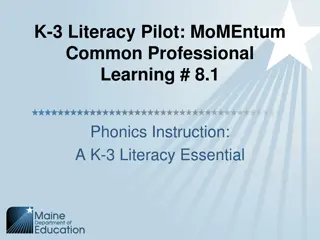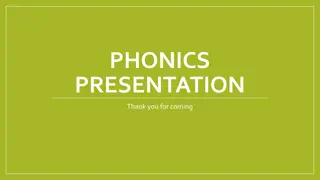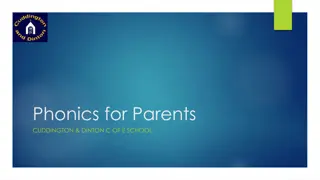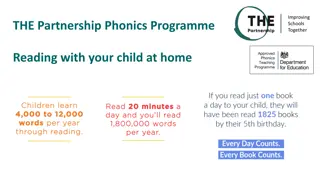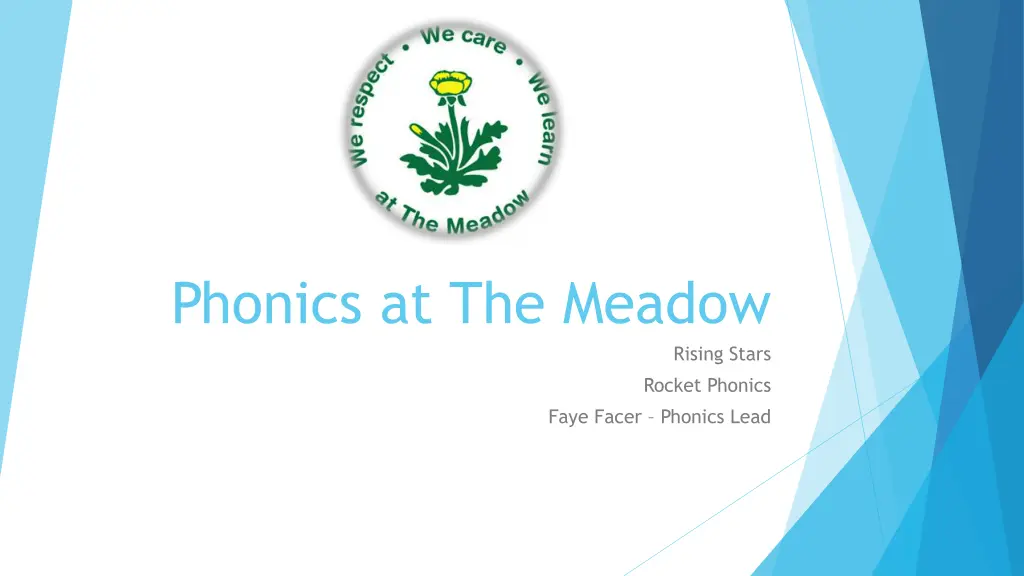
Importance of Reading and Language Development for Children
Discover the importance of reading, language comprehension, developing talk, word reading, and spelling in children's learning journey. Explore how these facets contribute to building crucial skills like concentration, creativity, empathy, and more.
Download Presentation

Please find below an Image/Link to download the presentation.
The content on the website is provided AS IS for your information and personal use only. It may not be sold, licensed, or shared on other websites without obtaining consent from the author. If you encounter any issues during the download, it is possible that the publisher has removed the file from their server.
You are allowed to download the files provided on this website for personal or commercial use, subject to the condition that they are used lawfully. All files are the property of their respective owners.
The content on the website is provided AS IS for your information and personal use only. It may not be sold, licensed, or shared on other websites without obtaining consent from the author.
E N D
Presentation Transcript
Phonics at The Meadow Rising Stars Rocket Phonics Faye Facer Phonics Lead
First of all: The importance of reading Why reading matters Building a love of reading, pleasure for reading Strengthening relationships Improves concentration Builds neural pathways Helps you gain further information Encourage creativity Develops empathy Teaches children about language
Language comprehension Comprehension does not refer to reading itself but, rather, to the way in which we make sense of words, sentences and the wider language we hear or read. Children need both good language comprehension and good word reading to become good readers.
Developing talk Language A language-rich environment is one in which adults talk with children throughout the day. The more children take part in conversations and discussion, the more they will understand once they can read and the more vocabulary and ideas they will have to draw on when they can write. Listening We need to teach children how to listen. Model being a good listener and praise when they have demonstrated this. Poetry and rhymes The predictability of rhymes in poems and songs also helps children to memorise and reuse newly acquired words and phrases. Learning poems including traditional nursery rhymes such as Hickory Dickory Dock , Little Jack Horner and Baa Baa Black Sheep can also heighten children s awareness of the individual sounds within words through alliteration, assonance and rhyme. For instance, because rhymes share the same end sound, they alert children to the contrast of the phonemes at the start of each word, as well as the repeated phonemes at the end, as in dock / clock , Horner / corner and Incy / Wincy
Word reading and spelling This is where phonics comes in! Decoding (word reading) and encoding (spelling) Phonemes Words are made up from small units of sound called phonemes. Phonics teaches children to be able to listen carefully and identify the phonemes that make up each word. This helps children to learn to read words and to spell words In phonics lessons children are taught three main things: Grapheme phoneme correspondences (GPCs) Blending Segmenting
GPCs Children are taught GPCs. This stands for grapheme phoneme correspondences. This simply means that they are taught all the phonemes in the English language and ways of writing them down. These sounds are taught in a particular order. The first sounds to be taught are s, a, t, i, p.
Blending Children are taught to be able to blend. This is when children say the sounds that make up a word and are able to merge the sounds together until they can hear what the word is. This skill is vital in learning to read. /b/ /e/ /d/ = bed /t/ /i/ /n/ = tin /m/ /u/ /g/ = mug
Segmenting (chopping up) Children are also taught to segment. This is the opposite of blending. Children are able to say a word and then break it up into the phonemes that make it up. This skill is vital in being able to spell words. bed = /b/ /e/ /d/ tin = /t/ /i/ /n/ mug = /m/ /u/ /g
Daily phonics Every day the children have a 30 minute session of phonics. The lessons incorporate opportunities for children to: - revisit and review previous learning - learn something new - practise that new learning and - apply it. Lessons encompass a range of oral rehearsal, stories, games, physical activity, matching, sorting,
Phonics words Your children will learn to use the term: phoneme - Phonemes are sounds that can be heard in words e.g. c-a-t grapheme - This is how a phoneme is written down e.g. goat digraph - This means that the phoneme comprises of two letters e.g. ll, ff, ck, ss trigraph - This means that the phoneme comprises of three letters e.g. igh , ear, air
Saying the sounds Sounds should be articulated clearly and precisely. Have a go at pronouncing these phonemes: a p l b h ai ur ph ie https://www.youtube.com/watch?v=BqhXUW_v-1s https://home.oxfordowl.co.uk/phonics-videos/#animation
Progression of teaching https://www.risingstars-uk.com/media/Rising-Stars/Reading/Rocket-Phonics- progression-chart_1.pdf Children will use the phonemes to read and spell simple consonant- vowel-consonant (CVC) words: sat, tap, dig, duck, corn, puff, sail, dark, sheep All these words contain 3 phonemes.
Tricky words There are many words that cannot be blended or segmented because they are irregular. the was said you some
Early Learning Goal Word Reading Say a sound for each letter in the alphabet and at least 10 digraphs. Read words consistent with their phonic knowledge by sound-blending. Read aloud simple sentences and books that are consistent with their phonic knowledge, including some common exception words.
Early Learning Goal Comprehension Demonstrate understanding of what has been read to them by retelling stories and narratives using their own words and recently introduced vocabulary. Anticipate (where appropriate) key events in stories. Use and understand recently introduced vocabulary during discussions about stories, nonfiction, rhymes and poems and during role play.
Decodable books and texts for children to read Decodable books and other texts make children feel successful from the very beginning. They do not encounter words that include GPCs they have not been taught. If an adult is not present, they are not forced to guess from pictures, the context, the first letters of a word or its shape Decodable books and texts that children read should run alongside or a little behind the teaching of the GPCs, so that they always feel a sense of achievement when they are asked to read such books. It is important that children practise their reading with decodable books or texts.
Early Learning Goal Writing Write recognisable letters, most of which are correctly formed. Spell words by identifying sounds in them and representing the sounds with a letter or letters. Write simple phrases and sentences that can be read by others.
How can you help at home? Talk to your children! Model talking and listening. Read everyday with your child. Ask questions about the story. What is the story about? What is your favourite part? Why? Use the front and back cover to scaffold your questioning and book talk Practise the phonemes sent home make words out of them Chop up words. Model segmenting words for your child to blend Let s get the b-u-s What s in the box? is a good game for this Help your child learn the tricky words. Stick them everywhere! Point to a tricky word and ask them what it is. Social Media




